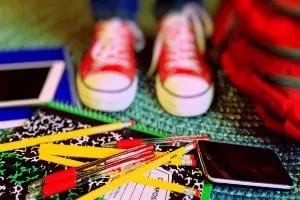
Now that your kids are back in the classroom, it’s the perfect time to rebalance your budget.
Like many families with school-age children, your budget probably needs some TLC right about now. Back-to-school season can be challenging at the best of times, and the pandemic didn’t make it any easier this year.
According to the National Retail Federation, the average family spent nearly $900 on back-to-school shopping. That’s a $59 bump from last year, as many families had to replenish supplies and upgrade clothes after skipping the usual shopping under lockdown.
If you overdid it this year, don’t worry. While overspending is never a good idea, sometimes it happens. And it’s hard to feel guilty when it means your kids are fully equipped for another school year.
That said, you shouldn’t ignore what overspending does to your budget. Here are some helpful tips on how to rebalance the budget and get your finances back on track.
Prioritize Emergency Savings
A budget helps you anticipate upcoming expenses so that you have the money you need, when you need it. But sometimes, you can’t always predict what will come your way.
Unfortunately, if your kid gets sick suddenly, you still have to take them to the doctor, even if you don’t have the money set aside in your budget.
Having emergency savings can help you cover this medical expense without stealing money away from other essentials, like what you need for your monthly utilities. So, you should make your contributions to this account a permanent fixture in your budget.
Experts suggest saving as much as six months of living expenses in this fund so that it can help you with any unexpected emergency. But if an emergency arrives before you hit your target, you have options. There are cash advances online that may work as backup.
The cash advance experts at MoneyKey recommend only ever using these online loans for unexpected emergencies that you can’t avoid. At Moneykey.com/cash-advance/, you can learn more about when cash advances may be an appropriate option.
Make a New Budget
To help you juggle emergency savings and your usual bills, you need to retool your budget. After all, your budget only works when it reflects your spending and earnings as they are right now. It needs an update since you’ve dipped into savings or credit to cover back-to-school shopping.
If you’re doing it by hand, you’ll want to make a t-chart that tallies all your earnings on one side and all your expenses on the other. As you start to list these expenses, make a note of what kind of spending they are — you’ll want to organize your list into categories of spending.
Here are some common categories and the expenses that fall within them:
- Housing costs: rent, mortgage, HOA bills
- Utilities: electricity, water, sewage, telecommunication services
- Food: groceries, takeout, meal boxes
- Entertainment: streaming services, festivals, concerts, movies, museums, travel
- Debts: outstanding cash advances, installment loans, lines of credit, credit card balances
- Household expenses: cleaning supplies, toiletries, repairs, maintenance
- Auto expenses: fuel, tolls, loans, insurance
Cut Expenses
Organizing your budget in this way can help you spot red flags. If a category of non-essential spending (like entertainment) takes up a good portion of your income, you can focus on it to cut costs. You can even involve your kids in this step if they’re old enough.
By tightening your belt, you can free up more cash to go toward savings, debt reduction, and next year’s back-to-school shopping.
A new school year will be here before you know it, so it’s a good idea to start planning for it now. The sacrifices you make now can help you weather next year’s back-to-school season with a little more confidence.
- Sagittarius Man & Gemini Woman Love and Sex Compatibility - January 31, 2024
- Taurus Ascendant Rising Personality Traits in Men (Guide) - January 31, 2024
- How to Seduce and Attract a Sagittarius Man (Seduction Tips) - January 31, 2024
